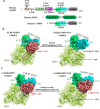NLRP inflammasomes in health and disease
- PMID: 38644450
- PMCID: PMC11033252
- DOI: 10.1186/s43556-024-00179-x
NLRP inflammasomes in health and disease
Abstract
NLRP inflammasomes are a group of cytosolic multiprotein oligomer pattern recognition receptors (PRRs) involved in the recognition of pathogen-associated molecular patterns (PAMPs) and danger-associated molecular patterns (DAMPs) produced by infected cells. They regulate innate immunity by triggering a protective inflammatory response. However, despite their protective role, aberrant NLPR inflammasome activation and gain-of-function mutations in NLRP sensor proteins are involved in occurrence and enhancement of non-communicating autoimmune, auto-inflammatory, and neurodegenerative diseases. In the last few years, significant advances have been achieved in the understanding of the NLRP inflammasome physiological functions and their molecular mechanisms of activation, as well as therapeutics that target NLRP inflammasome activity in inflammatory diseases. Here, we provide the latest research progress on NLRP inflammasomes, including NLRP1, CARD8, NLRP3, NLRP6, NLRP7, NLRP2, NLRP9, NLRP10, and NLRP12 regarding their structural and assembling features, signaling transduction and molecular activation mechanisms. Importantly, we highlight the mechanisms associated with NLRP inflammasome dysregulation involved in numerous human auto-inflammatory, autoimmune, and neurodegenerative diseases. Overall, we summarize the latest discoveries in NLRP biology, their forming inflammasomes, and their role in health and diseases, and provide therapeutic strategies and perspectives for future studies about NLRP inflammasomes.
Keywords: Auto-inflammatory; Autoimmune; Health and disease; NLRP inflammasome; Neurological disorders; Therapeutic inhibitor.
© 2024. The Author(s).
Conflict of interest statement
The authors declare that they have no competing interests.
Figures






Similar articles
-
Molecular mechanisms of emerging inflammasome complexes and their activation and signaling in inflammation and pyroptosis.Immunol Rev. 2025 Jan;329(1):e13406. doi: 10.1111/imr.13406. Epub 2024 Oct 1. Immunol Rev. 2025. PMID: 39351983 Free PMC article. Review.
-
NLRP7: From inflammasome regulation to human disease.Immunology. 2021 Aug;163(4):363-376. doi: 10.1111/imm.13372. Epub 2021 Jun 30. Immunology. 2021. PMID: 34021586 Free PMC article. Review.
-
The NLRP1 and CARD8 inflammasomes.Immunol Rev. 2020 Sep;297(1):13-25. doi: 10.1111/imr.12884. Epub 2020 Jun 19. Immunol Rev. 2020. PMID: 32558991 Free PMC article. Review.
-
NLRP12 interacts with NLRP3 to block the activation of the human NLRP3 inflammasome.Sci Signal. 2024 Jan 23;17(820):eabg8145. doi: 10.1126/scisignal.abg8145. Epub 2024 Jan 23. Sci Signal. 2024. PMID: 38261657
-
The CARD8 T60 variant associates with NLRP1 and negatively regulates its activation.Front Immunol. 2022 Nov 8;13:1047922. doi: 10.3389/fimmu.2022.1047922. eCollection 2022. Front Immunol. 2022. PMID: 36426349 Free PMC article.
Cited by
-
Evolutionary Dynamics of Proinflammatory Caspases in Primates and Rodents.Mol Biol Evol. 2024 Dec 6;41(12):msae220. doi: 10.1093/molbev/msae220. Mol Biol Evol. 2024. PMID: 39431598 Free PMC article.
-
NOX2 mediates NLRP3/ROS facilitating nasal mucosal epithelial inflammation in chronic rhinosinusitis with nasal polyps.Heliyon. 2024 Sep 17;10(18):e38029. doi: 10.1016/j.heliyon.2024.e38029. eCollection 2024 Sep 30. Heliyon. 2024. PMID: 39328569 Free PMC article.
-
Inflammasomes: potential therapeutic targets in hematopoietic stem cell transplantation.Cell Commun Signal. 2024 Dec 18;22(1):596. doi: 10.1186/s12964-024-01974-3. Cell Commun Signal. 2024. PMID: 39695742 Free PMC article. Review.
-
The Role of Inflammation in the Pathogenesis of Viral Respiratory Infections.Microorganisms. 2024 Dec 7;12(12):2526. doi: 10.3390/microorganisms12122526. Microorganisms. 2024. PMID: 39770727 Free PMC article. Review.
-
Therapeutic targeting of the host-microbiota-immune axis: implications for precision health.Front Immunol. 2025 Apr 29;16:1570233. doi: 10.3389/fimmu.2025.1570233. eCollection 2025. Front Immunol. 2025. PMID: 40364844 Free PMC article. Review.
References
Publication types
MeSH terms
Substances
Grants and funding
- 2022YFC2304102/Key Technologies Research and Development Program
- 31971129/National Natural Science Foundation of China
- 82272301/National Natural Science Foundation of China
- 2022i01020025/Anhui Provincial Key Research and Development Project
- WK9100000001/Fundamental Research Funds for the Central Universities
LinkOut - more resources
Full Text Sources
